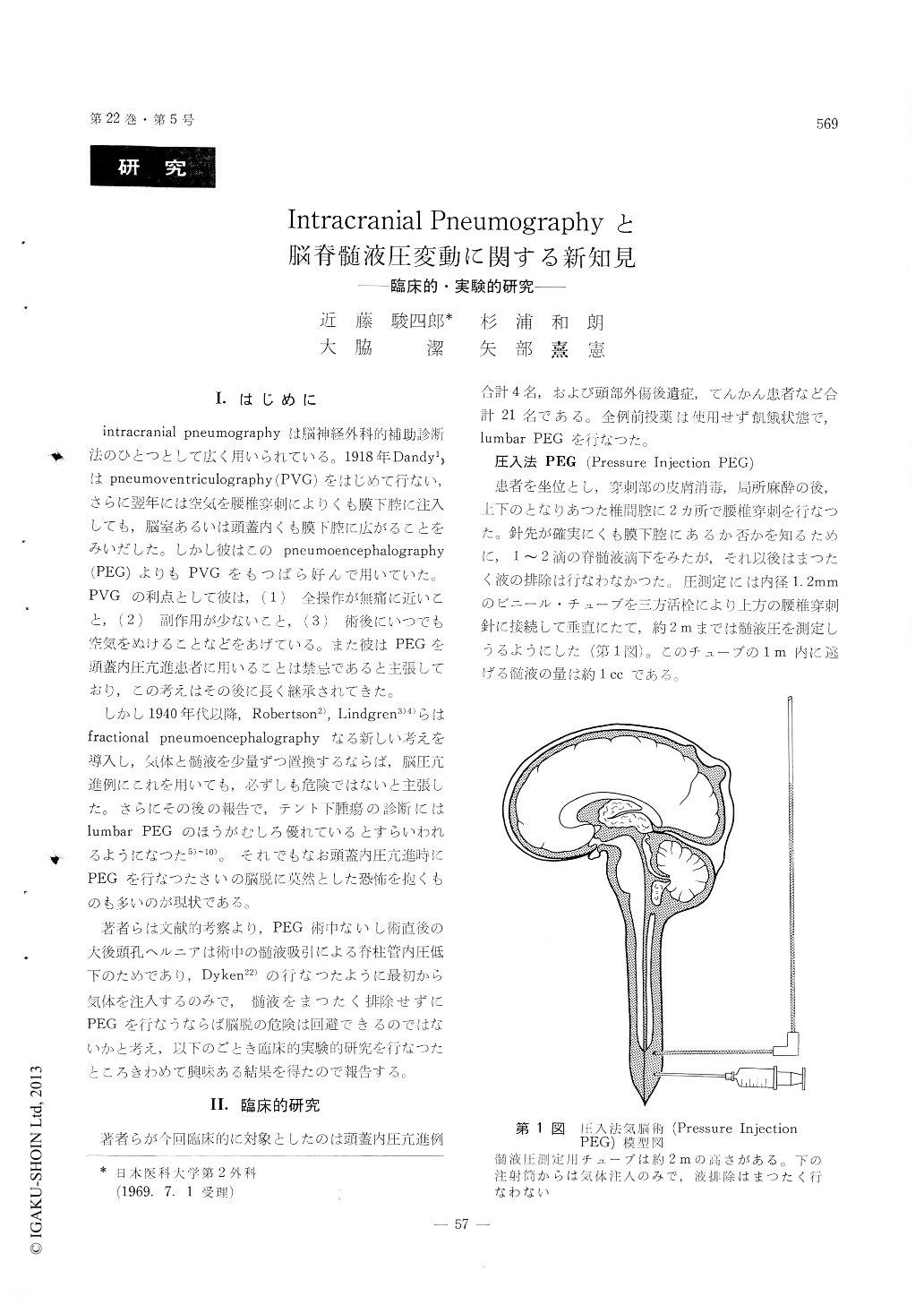Japanese
English
- 有料閲覧
- Abstract 文献概要
- 1ページ目 Look Inside
I.はじめに
intracranial pneumographyは脳神経外科的補助診断法のひとつとして広く用いられている。1918年Dandy1)はpneumoventriculography (PVG)をはじめて行ない,さらに翌年には空気を腰椎穿刺によりくも膜下腔に注入しても,脳室あるいは頭蓋内くも膜下腔に広がることをみいだした。しかし彼はこのpneumoencephalography(PEG)よりもPVGをもつぱら好んで用いていた。PVGの利点として彼は,(1)全操作が無痛に近いこと,(2)副作用が少ないこと,(3)術後にいつでも空気をぬけることなどをあげている。また彼はPEGを頭蓋内圧亢進患者に用いることは禁忌であると主張しており,この考えはその後に長く継承されてきた。
しかし1940年代以降,Robertson2), Lindgren3)4)らはfractional pneumoencephalographyなる新しい考えを導入し,気体と髄液を少量ずつ置換するならば,脳圧亢進例にこれを用いても,必ずしも危険ではないと主張した。さらにその後の報告で,テント下腫瘍の診断にはlumbar PEGのほうがむしろ優れているとすらいわれるようになった5)〜10)。それでもなお頭蓋内圧亢進時にPEGを行なったさいの脳脱に莫然とした恐怖を抱くものも多いのが現状である。
1. Two different types of pneumoencephalography were obtained on 36 patients, including 14 patients who had a high intracranial pressure.
2. All of the high intracranial pressure cases and others were introduced various amounts of air intra-thecally without removal of the cerebrospinal fluid throughout the procedure (Pressure Injec-tion PEG). Examining cerebrospinal fluid pressure before, during, and after the procedure, authorsfound that depression of pressure occurred soon after this procedure and lasted for several days in almost all cases, whether the original pressure was high or normal.
3. In six patients with normal cerebrospinal fluid pressure "overflow PEG" was done, in which fluid escapes freely from the cut manometer tube to maintain the initial pressure when the air was in-jected into the lumbar subarachnoid space. This group of patients showed no significant alteration in pressure after 24 and 72 hours.
4. The above findings were ascertained in ex-perimental studies on dogs.
5. Danger of cerebellar tonsillar herniation during and soon after lumbar pneumoencephalography can be avoided, if absolutely no cerebrospinal fluid is withdrawn during the procedure, even in the patients with high intracranial pressure. Later manifestation of coning would also never happen as it is demons-trated by "overflow PEG" that leakage of cere-brospinal fluid through the dural puncture hole and resulting low intraspinous pressure can never take place.
6. During and soon after the "pressure injection PEG" of air, i. e., during the cerebrospinal fluid pressure rises above the initial level, constriction of craniospinal vascular bed and increase in absorption of cerebrospinal fluid occur according to the degree of elevation of pressure from the original value. These changes may continue until the pressure returned to its equilibrium value.
7. Depression of pressure below the initial level may be due to decrease of resistance in cerebrospinal fluid absorption by an induced sudden increment of hydrostatic pressure during "pressure injection".
8. "Pressure injection PEG" is not only harmless to those who have high intracranial pressure but also advantageous for its depressive effect of in-tracranial pressure lasting several days.

Copyright © 1970, Igaku-Shoin Ltd. All rights reserved.


